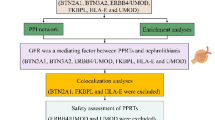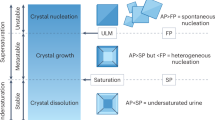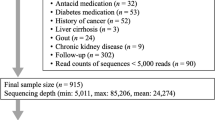Abstract
A previous genome-wide association study (GWAS) reported three novel nephrolithiasis-susceptibility loci at 5q35.3, 7p14.3 and 13q14.1. Here, we investigated the association of these loci with nephrolithiasis by using an independent Japanese sample set. We performed case–control association analysis using 601 patients with nephrolithiasis and 201 control subjects. We selected seven single-nucleotide polymorphisms (SNPs): rs12654812 and rs11746443 from 5q35.3 (RGS14-SLC34A1-PFN3-F12); rs12669187 and rs1000597 from 7p14.3 (INMT-FAM188B-AQP1); and rs7981733, rs1170155, and rs4142110 from 13q14.1 (DGKH (diacylglycerol kinase)), which were previously reported to be significantly associated with nephrolithiasis. rs12654812, rs12669187 and rs7981733 were significantly associated with nephrolithiasis after Bonferroni’s correction (P=3.12 × 10−3, odds ratio (OR)=1.43; P=6.40 × 10−3, OR=1.57; and P=5.00 × 10−3, OR=1.41, respectively). Meta-analysis of current and previous GWAS results indicated a significant association with nephrolithiasis (P=7.65 × 10−15, 7.86 × 10−14 and 1.06 × 10−9, respectively). We observed a cumulative effect with these three SNPs; individuals with three or more risk alleles had a 5.9-fold higher risk for nephrolithiasis development than those with only one risk allele. Our findings elucidated the significance of genetic variation at these three loci in nephrolithiasis in the Japanese population.
Similar content being viewed by others
Log in or create a free account to read this content
Gain free access to this article, as well as selected content from this journal and more on nature.com
or
References
Yasui, T., Iguchi, M., Suzuki, S. & Kohri, K. Prevalence and epidemiological characteristics of urolithiasis in Japan: national trends between 1965 and 2005. Urology 71, 209–213 (2008).
Strohmaier, W. L. Course of calcium stone disease without treatment. What can we expect? Eur. Urol. 37, 339–344 (2000).
Tasca, A. Metabolic syndrome and bariatric surgery in stone disease etiology. Curr. Opin. Urol. 21, 129–133 (2011).
Taylor, E. N., Stampfer, M. J. & Curhan, G. C. Obesity, weight gain, and the risk of kidney stones. J. Am. Med. Assoc. 293, 455–462 (2005).
Worcester, E. M. & Coe, F. L. Clinical practice. Calcium kidney stones. N. Engl. J. Med. 363, 954–963 (2010).
Curhan, G. C., Willett, W. C., Rimm, E. B. & Stampfer, M. J. Family history and risk of kidney stones. J. Am. Soc. Nephrol. 8, 1568–1573 (1997).
Goldfarb, D. S., Fischer, M. E., Keich, Y. & Goldberg, J. A twin study of genetic and dietary influences on nephrolithiasis: a report from the Vietnam EraTwin (VET) Registry. Kidney Int. 67, 1053–1061 (2005).
Vezzoli, G., Terranegra, A., Arcidiacono, T. & Soldati, L. Genetics and calcium nephrolithiasis. Kidney Int. 80, 587–593 (2011).
Urabe, Y., Tanikawa, C., Takahashi, A., Okada, Y., Morizono, T., Tsunoda, T. et al. A genome-wide association study of nephrolithiasis in the Japanese population identifies novel susceptible Loci at 5q35.3, 7p14.3, and 13q14.1. PLoS Genet. 8, e1002541 (2012).
Matsuo, S., Imai, E., Horio, M., Yasuda, Y., Tomita, K., Nitta, K. et al. Revised equations for estimated GFR from serum creatinine in Japan. Am. J. Kidney Dis. 53, 982–992 (2009).
Nakamura, Y. The BioBank Japan Project. Clin. Adv. Hematol. Oncol. 5, 696–697 (2007).
Purcell, S., Neale, B., Todd-Brown, K., Thomas, L., Ferreira, M. A., Bender, D. et al. PLINK: a tool set for whole-genome association and population-based linkage analyses. Am. J. Hum. Genet. 81, 559–575 (2007).
Breslow, N. E. & Day, N. E. Statistical methods in cancer research. Volume II—The design and analysis of cohort studies. IARC Sci. Publ. 82, 1–406 (1987).
Weinman, E. J., Cunningham, R., Wade, J. B. & Shenolikar, S. The role of NHERF-1 in the regulation of renal proximal tubule sodium-hydrogen exchanger 3 and sodium-dependent phosphate cotransporter 2a. J. Physiol. 567, 27–32 (2005).
Prié, D., Huart, V., Bakouh, N., Planelles, G., Dellis, O., Gérard, B. et al. Nephrolithiasis and osteoporosis associated with hypophosphatemia caused by mutations in the type 2a sodium-phosphate cotransporter. N. Engl. J. Med. 347, 983–991 (2002).
Beck, L., Karaplis, A. C., Amizuka, N., Hewson, A. S., Ozawa, H., Tenenhouse, H. S. et al. Targeted inactivation of Npt2 in mice leads to severe renal phosphate wasting, hypercalciuria, and skeletal abnormalities. Proc. Natl Acad. Sci. USA 95, 5372–5377 (1998).
Köttgen, A., Pattaro, C., Böger, C. A., Fuchsberger, C., Olden, M., Glazer, N. L. et al. New loci associated with kidney function and chronic kidney disease. Nat. Genet. 42, 376–384 (2010).
Kestenbaum, B., Glazer, N. L., Köttgen, A., Felix, J. F., Hwang, S. J., Liu, Y. et al. Common genetic variants associate with serum phosphorus concentration. J. Am. Soc. Nephrol. 21, 1223–1232 (2010).
Lapointe, J. Y., Tessier, J., Paquette, Y., Wallendorff, B., Coady, M. J., Pichette, V. et al. NPT2a gene variation in calcium nephrolithiasis with renal phosphate leak. Kidney Int. 69, 2261–2267 (2006).
Khan, S. R. Calcium phosphate/calcium oxalate crystal association in urinary stones: implications for heterogeneous nucleation of calcium oxalate. J. Urol. 157, 376–383 (1997).
Coe, F. L., Evan, A. P., Worcester, E. M. & Lingeman, J. E. Three pathways for human kidney stone formation. Urol. Res. 38, 147–160 (2010).
Randall, A. The origin and growth of renal calculi. Ann. Surg. 105, 1009–1027 (1937).
Evan, A. P., Lingeman, J. E., Coe, F. L., Parks, J. H., Bledsoe, S. B., Shao, Y. et al. Randall's plaque of patients with nephrolithiasis begins in basement membranes of thin loops of Henle. J. Clin. Invest. 111, 607–616 (2003).
Ma, T., Yang, B., Gillespie, A., Carlson, E. J., Epstein, C. J. & Verkman, A. S. Severely impaired urinary concentrating ability in transgenic mice lacking aquaporin-1 water channels. J. Biol. Chem. 273, 4296–4299 (1998).
Barnett, J. H. & Smoller, J. W. The genetics of bipolar disorder. Neuroscience 164, 331–343 (2009).
Thorleifsson, G., Holm, H., Edvardsson, V., Walters, G. B., Styrkarsdottir, U., Gudbjartsson, D. F. et al. Sequence variants in the CLDN14 gene associate with kidney stones and bone mineral density. Nat. Genet. 41, 926–930 (2009).
Kapur, K., Johnson, T., Beckmann, N. D., Sehmi, J., Tanaka, T., Kutalik, Z. et al. Genome-wide meta-analysis for serum calcium identifies significantly associated SNPs near the calcium-sensing receptor (CASR) gene. PLoS Genet. 6, e1001035 (2010).
Acknowledgements
We thank Ms Ichikawa, Ms Kawamura, Ms Noda and Ms Kasuga for their secretarial assistance. This work was partly supported by MEXT/JSPSKAKENHI (grant numbers 23249074, 23592375, 24659716 and 24689060); the BioBank Japan Project funded by the Japanese Ministry of Education, Culture, Sports, Science and Technology; the Takeda Science Foundation; and the Japanese Urological Association. The funders had no role in the study design, data collection and analysis, decision to publish or preparation of the manuscript.
Author information
Authors and Affiliations
Corresponding author
Ethics declarations
Competing interests
The authors declare no conflict of interest.
Rights and permissions
About this article
Cite this article
Yasui, T., Okada, A., Urabe, Y. et al. A replication study for three nephrolithiasis loci at 5q35.3, 7p14.3 and 13q14.1 in the Japanese population. J Hum Genet 58, 588–593 (2013). https://doi.org/10.1038/jhg.2013.59
Received:
Revised:
Accepted:
Published:
Issue date:
DOI: https://doi.org/10.1038/jhg.2013.59
Keywords
This article is cited by
-
The rs1256328 (ALPL) and rs12654812 (RGS14) Polymorphisms are Associated with Susceptibility to Calcium Nephrolithiasis in a Taiwanese population
Scientific Reports (2019)
-
Renal phosphate handling and inherited disorders of phosphate reabsorption: an update
Pediatric Nephrology (2019)
-
Clinical aspects of the phosphate transporters NaPi-IIa and NaPi-IIb: mutations and disease associations
Pflügers Archiv - European Journal of Physiology (2019)
-
Meeting report of the “Symposium on kidney stones and mineral metabolism: calcium kidney stones in 2017”
Journal of Nephrology (2019)
-
Association Study of Reported Significant Loci at 5q35.3, 7p14.3, 13q14.1 and 16p12.3 with Urolithiasis in Chinese Han Ethnicity
Scientific Reports (2017)



